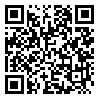Volume 10, Issue 2 (2021)
JFST 2021, 10(2): 151-163 |
Back to browse issues page
Download citation:
BibTeX | RIS | EndNote | Medlars | ProCite | Reference Manager | RefWorks
Send citation to:



BibTeX | RIS | EndNote | Medlars | ProCite | Reference Manager | RefWorks
Send citation to:
koosej N, Jafariyan H, rahmani A, Patimar A, Gholipoor H. Evaluation of heavy metal pollution and investigation of the source of environmental pollution of sediments in Qeshm, Bandar Khamir and Bandar Laft areas of Hormozgan province in the Persian Gulf. JFST 2021; 10 (2) :151-163
URL: http://jfst.modares.ac.ir/article-6-51009-en.html
URL: http://jfst.modares.ac.ir/article-6-51009-en.html
Naser Koosej *  1, Hojatollah Jafariyan2
1, Hojatollah Jafariyan2  , Abdolvahed Rahmani3
, Abdolvahed Rahmani3  , Abdolrahman Patimar2
, Abdolrahman Patimar2  , Hosna Gholipoor2
, Hosna Gholipoor2 
 1, Hojatollah Jafariyan2
1, Hojatollah Jafariyan2  , Abdolvahed Rahmani3
, Abdolvahed Rahmani3  , Abdolrahman Patimar2
, Abdolrahman Patimar2  , Hosna Gholipoor2
, Hosna Gholipoor2 
1- Department of Chemistry, Faculty of Basic Sciences, Hormozgan University, Bandar Abbas, Iran , naserkooseg@yahoo.com
2- Department of Fisheries, Faculty of Basic Sciences, Gonbad Kavous University, Gonbad Kavous, Iran
3- Department of Chemistry, Faculty of Basic Sciences, Hormozgan University, Bandar Abbas, Iran
2- Department of Fisheries, Faculty of Basic Sciences, Gonbad Kavous University, Gonbad Kavous, Iran
3- Department of Chemistry, Faculty of Basic Sciences, Hormozgan University, Bandar Abbas, Iran
Abstract: (1709 Views)
In this study, coastal sediments of Qeshm, Bandar Khamir and Bandar Laft regions in Hormozgan province were studied to determine the level of contamination of heavy metals lead, nickel, zinc, iron and copper by natural processes or human activities. In order to identify environmental pollutants caused by heavy metals, shovel sampling was performed from the sediments of these areas to measure the concentration of heavy metals and determine the enrichment index. The location of the samples was determined using a GPS device and sampling of surface sediments (tidal zone) was performed at 30 stations in the study areas. Atomic absorption of flame spectrometry was used to determine the concentration of heavy metals. The results showed that the mean concentrations of heavy elements lead, nickel, zinc, iron and copper in all sampling stations showed a significant difference (p<0.05). In terms of concentration of studied elements in Qeshm region (copper: 33.76 ± 1.88, zinc: 85.44 ± 2.75, lead: 31.79± 1.23, nickel: 34.17 ± 2.29 and Iron: 38000±691.21 μg/g) compared to Bandar Khamir (copper: 26.84 ± 2.30, zinc: 77.54 ± 2.12, lead: 24.71± 1.37, nickel:25.82± 1.30 and iron: 36810± 482.882 μg/g) and Bandar Laft (copper: 22.74± 2.42, zinc: 65.22±2.61, lead: 19.93± 1.32, nickel: 21.70±2.06 and iron: 35560±1014.56 μg/g) had higher contamination. The results also showed that the metal enrichment factor is low in all sediment samples and in terms of Müller geochemical index, the degree of soil contamination is in the category of non-contaminated soils.
Keywords: Heavy Metals, Pollution, Persian Gulf, Sediment, Enrichment factor and Müller Geochemical Index
Article Type: Original Research |
Subject:
Aquatic pollution and waste water management
Received: 2021/03/17 | Published: 2021/05/2
Received: 2021/03/17 | Published: 2021/05/2
Send email to the article author
| Rights and permissions | |
 |
This work is licensed under a Creative Commons Attribution-NonCommercial 4.0 International License. |







